Risk-Based Approach to ML/TF in Australian Financial Institutions
VerifiedAdded on 2022/10/10
|5
|914
|140
Report
AI Summary
This report addresses the Money Laundering and Terrorism Financing (ML/TF) risks faced by a small regional Australian bank introducing online banking services. It identifies potential risks such as identity fraud and vulnerability risks, and suggests controls like transaction monitoring and enhanced due diligence. The report also examines industry changes that could increase ML/TF risks, such as technological advancements and evolving customer demands. It emphasizes the need for robust AML/CTF controls, including customer identity verification, transaction monitoring, and staff training, to mitigate these risks. The report highlights the significance of a risk-based approach, efficient KYC/CDD, and FATA framework, and the impact of effective AML/CTF controls on the financial system's integrity. The report references key literature on the subject, including works by Levi (2010), Ross and Hannan (2017), Sadiq and Governatori (2010), and Solin and Zerzan (2014).
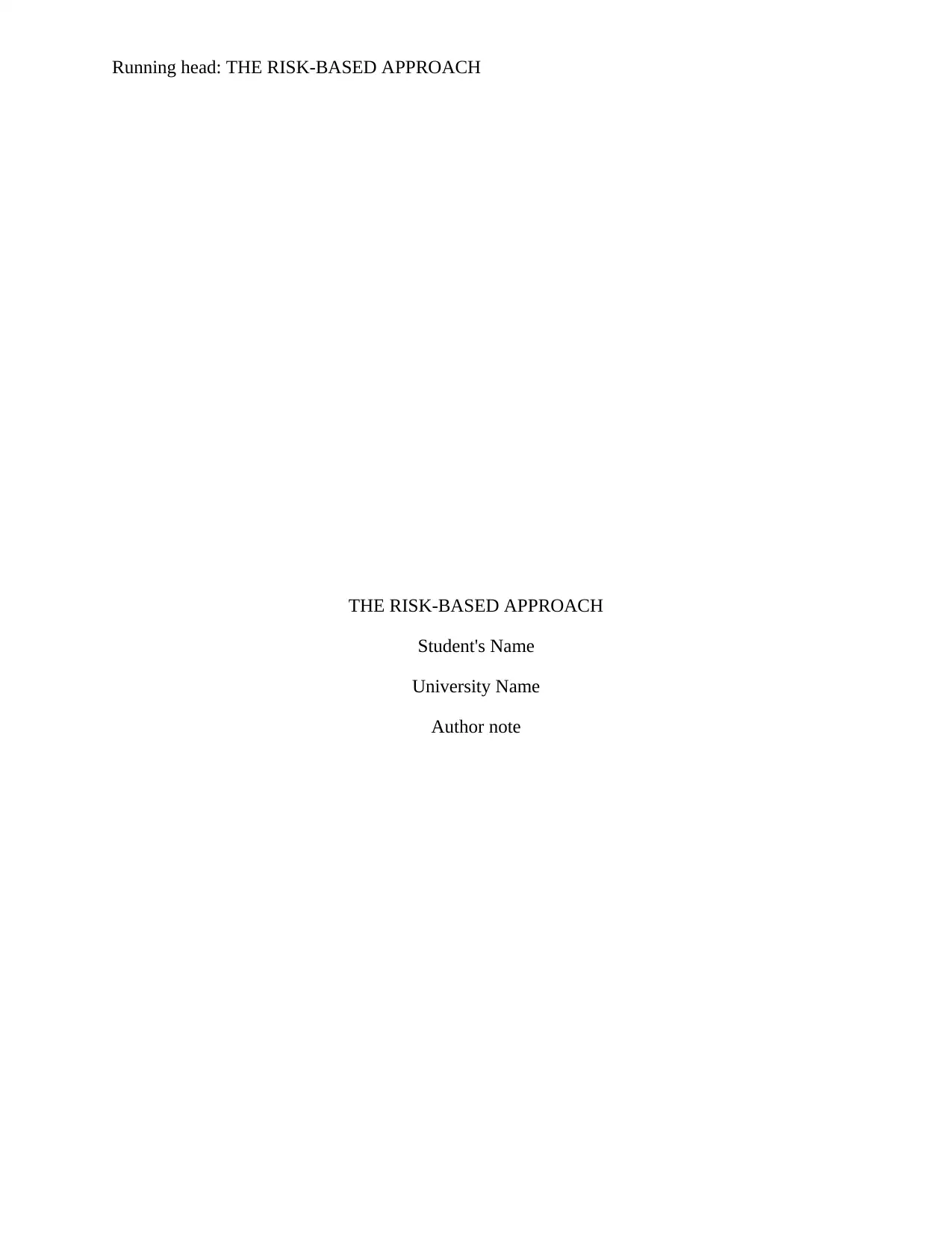
Running head: THE RISK-BASED APPROACH
THE RISK-BASED APPROACH
Student's Name
University Name
Author note
THE RISK-BASED APPROACH
Student's Name
University Name
Author note
Paraphrase This Document
Need a fresh take? Get an instant paraphrase of this document with our AI Paraphraser
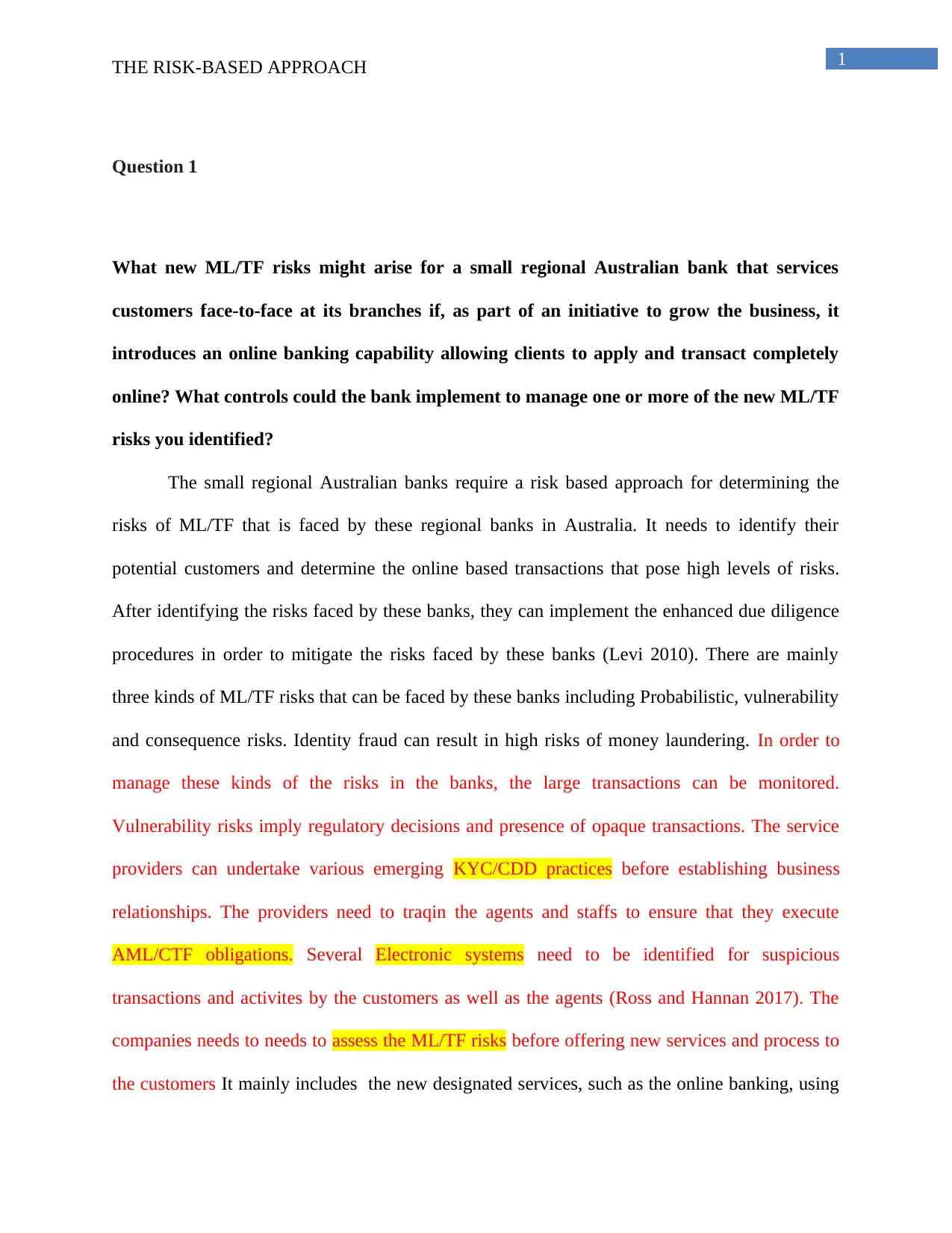
1THE RISK-BASED APPROACH
Question 1
What new ML/TF risks might arise for a small regional Australian bank that services
customers face-to-face at its branches if, as part of an initiative to grow the business, it
introduces an online banking capability allowing clients to apply and transact completely
online? What controls could the bank implement to manage one or more of the new ML/TF
risks you identified?
The small regional Australian banks require a risk based approach for determining the
risks of ML/TF that is faced by these regional banks in Australia. It needs to identify their
potential customers and determine the online based transactions that pose high levels of risks.
After identifying the risks faced by these banks, they can implement the enhanced due diligence
procedures in order to mitigate the risks faced by these banks (Levi 2010). There are mainly
three kinds of ML/TF risks that can be faced by these banks including Probabilistic, vulnerability
and consequence risks. Identity fraud can result in high risks of money laundering. In order to
manage these kinds of the risks in the banks, the large transactions can be monitored.
Vulnerability risks imply regulatory decisions and presence of opaque transactions. The service
providers can undertake various emerging KYC/CDD practices before establishing business
relationships. The providers need to traqin the agents and staffs to ensure that they execute
AML/CTF obligations. Several Electronic systems need to be identified for suspicious
transactions and activites by the customers as well as the agents (Ross and Hannan 2017). The
companies needs to needs to assess the ML/TF risks before offering new services and process to
the customers It mainly includes the new designated services, such as the online banking, using
Question 1
What new ML/TF risks might arise for a small regional Australian bank that services
customers face-to-face at its branches if, as part of an initiative to grow the business, it
introduces an online banking capability allowing clients to apply and transact completely
online? What controls could the bank implement to manage one or more of the new ML/TF
risks you identified?
The small regional Australian banks require a risk based approach for determining the
risks of ML/TF that is faced by these regional banks in Australia. It needs to identify their
potential customers and determine the online based transactions that pose high levels of risks.
After identifying the risks faced by these banks, they can implement the enhanced due diligence
procedures in order to mitigate the risks faced by these banks (Levi 2010). There are mainly
three kinds of ML/TF risks that can be faced by these banks including Probabilistic, vulnerability
and consequence risks. Identity fraud can result in high risks of money laundering. In order to
manage these kinds of the risks in the banks, the large transactions can be monitored.
Vulnerability risks imply regulatory decisions and presence of opaque transactions. The service
providers can undertake various emerging KYC/CDD practices before establishing business
relationships. The providers need to traqin the agents and staffs to ensure that they execute
AML/CTF obligations. Several Electronic systems need to be identified for suspicious
transactions and activites by the customers as well as the agents (Ross and Hannan 2017). The
companies needs to needs to assess the ML/TF risks before offering new services and process to
the customers It mainly includes the new designated services, such as the online banking, using
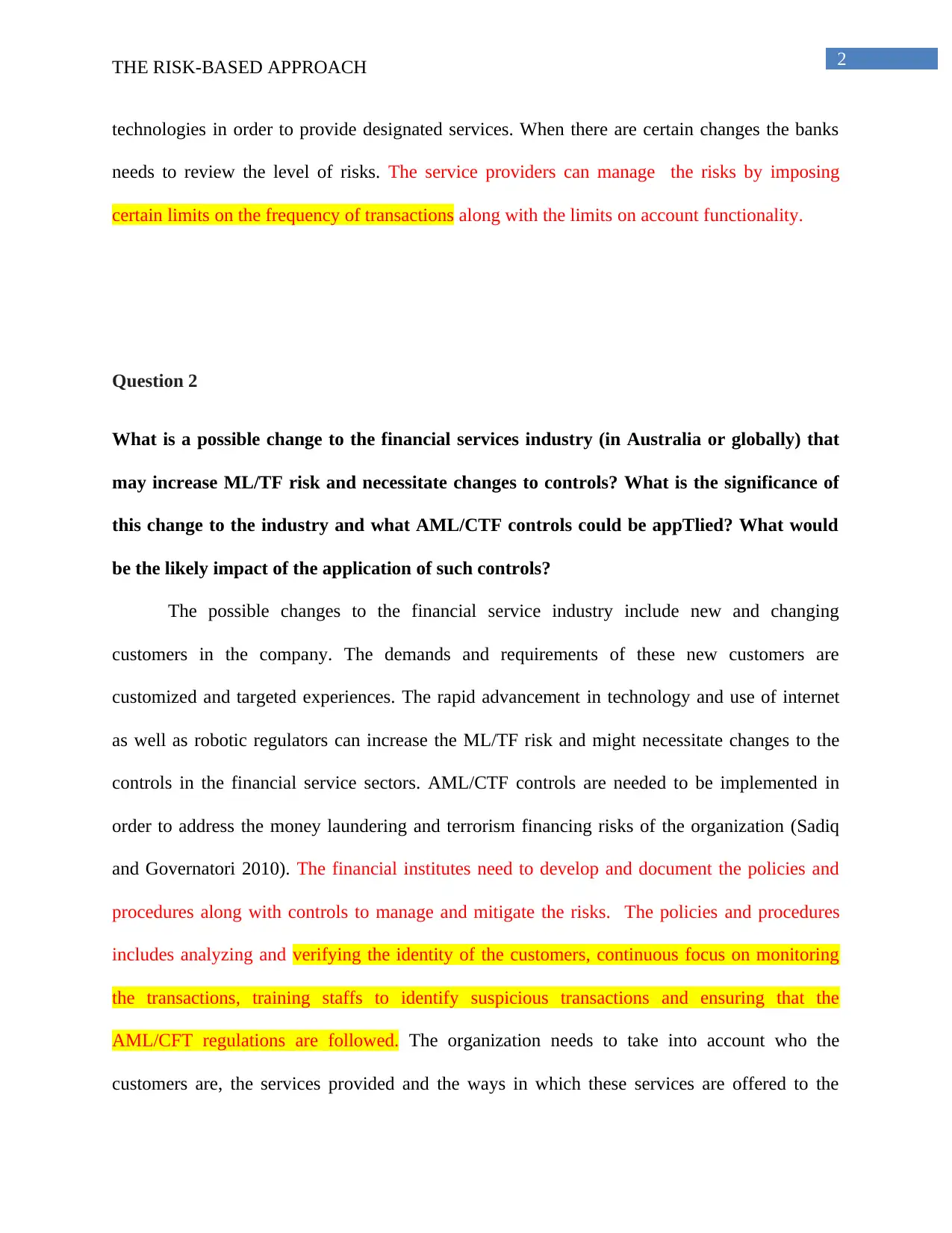
2THE RISK-BASED APPROACH
technologies in order to provide designated services. When there are certain changes the banks
needs to review the level of risks. The service providers can manage the risks by imposing
certain limits on the frequency of transactions along with the limits on account functionality.
Question 2
What is a possible change to the financial services industry (in Australia or globally) that
may increase ML/TF risk and necessitate changes to controls? What is the significance of
this change to the industry and what AML/CTF controls could be appTlied? What would
be the likely impact of the application of such controls?
The possible changes to the financial service industry include new and changing
customers in the company. The demands and requirements of these new customers are
customized and targeted experiences. The rapid advancement in technology and use of internet
as well as robotic regulators can increase the ML/TF risk and might necessitate changes to the
controls in the financial service sectors. AML/CTF controls are needed to be implemented in
order to address the money laundering and terrorism financing risks of the organization (Sadiq
and Governatori 2010). The financial institutes need to develop and document the policies and
procedures along with controls to manage and mitigate the risks. The policies and procedures
includes analyzing and verifying the identity of the customers, continuous focus on monitoring
the transactions, training staffs to identify suspicious transactions and ensuring that the
AML/CFT regulations are followed. The organization needs to take into account who the
customers are, the services provided and the ways in which these services are offered to the
technologies in order to provide designated services. When there are certain changes the banks
needs to review the level of risks. The service providers can manage the risks by imposing
certain limits on the frequency of transactions along with the limits on account functionality.
Question 2
What is a possible change to the financial services industry (in Australia or globally) that
may increase ML/TF risk and necessitate changes to controls? What is the significance of
this change to the industry and what AML/CTF controls could be appTlied? What would
be the likely impact of the application of such controls?
The possible changes to the financial service industry include new and changing
customers in the company. The demands and requirements of these new customers are
customized and targeted experiences. The rapid advancement in technology and use of internet
as well as robotic regulators can increase the ML/TF risk and might necessitate changes to the
controls in the financial service sectors. AML/CTF controls are needed to be implemented in
order to address the money laundering and terrorism financing risks of the organization (Sadiq
and Governatori 2010). The financial institutes need to develop and document the policies and
procedures along with controls to manage and mitigate the risks. The policies and procedures
includes analyzing and verifying the identity of the customers, continuous focus on monitoring
the transactions, training staffs to identify suspicious transactions and ensuring that the
AML/CFT regulations are followed. The organization needs to take into account who the
customers are, the services provided and the ways in which these services are offered to the
⊘ This is a preview!⊘
Do you want full access?
Subscribe today to unlock all pages.

Trusted by 1+ million students worldwide
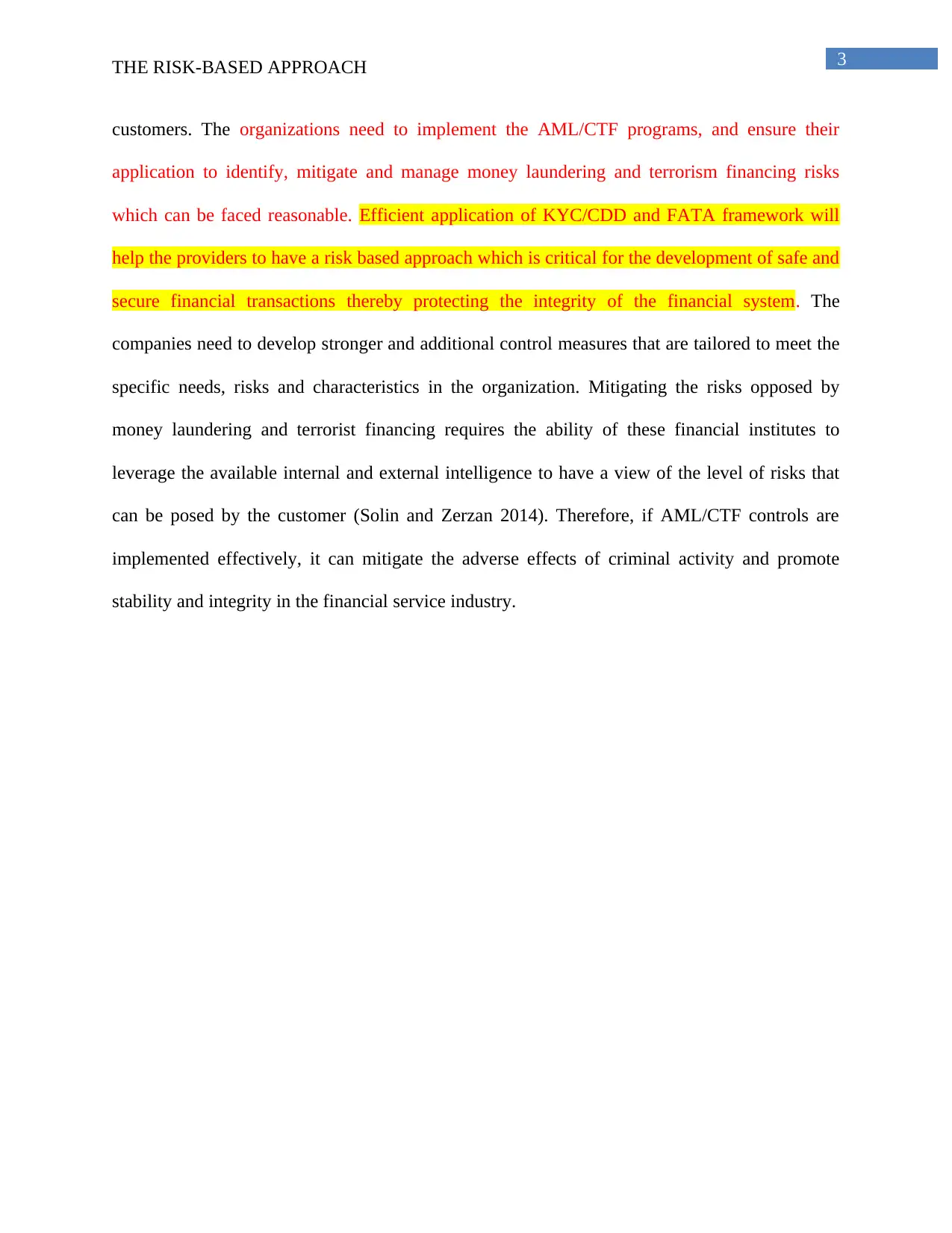
3THE RISK-BASED APPROACH
customers. The organizations need to implement the AML/CTF programs, and ensure their
application to identify, mitigate and manage money laundering and terrorism financing risks
which can be faced reasonable. Efficient application of KYC/CDD and FATA framework will
help the providers to have a risk based approach which is critical for the development of safe and
secure financial transactions thereby protecting the integrity of the financial system. The
companies need to develop stronger and additional control measures that are tailored to meet the
specific needs, risks and characteristics in the organization. Mitigating the risks opposed by
money laundering and terrorist financing requires the ability of these financial institutes to
leverage the available internal and external intelligence to have a view of the level of risks that
can be posed by the customer (Solin and Zerzan 2014). Therefore, if AML/CTF controls are
implemented effectively, it can mitigate the adverse effects of criminal activity and promote
stability and integrity in the financial service industry.
customers. The organizations need to implement the AML/CTF programs, and ensure their
application to identify, mitigate and manage money laundering and terrorism financing risks
which can be faced reasonable. Efficient application of KYC/CDD and FATA framework will
help the providers to have a risk based approach which is critical for the development of safe and
secure financial transactions thereby protecting the integrity of the financial system. The
companies need to develop stronger and additional control measures that are tailored to meet the
specific needs, risks and characteristics in the organization. Mitigating the risks opposed by
money laundering and terrorist financing requires the ability of these financial institutes to
leverage the available internal and external intelligence to have a view of the level of risks that
can be posed by the customer (Solin and Zerzan 2014). Therefore, if AML/CTF controls are
implemented effectively, it can mitigate the adverse effects of criminal activity and promote
stability and integrity in the financial service industry.
Paraphrase This Document
Need a fresh take? Get an instant paraphrase of this document with our AI Paraphraser
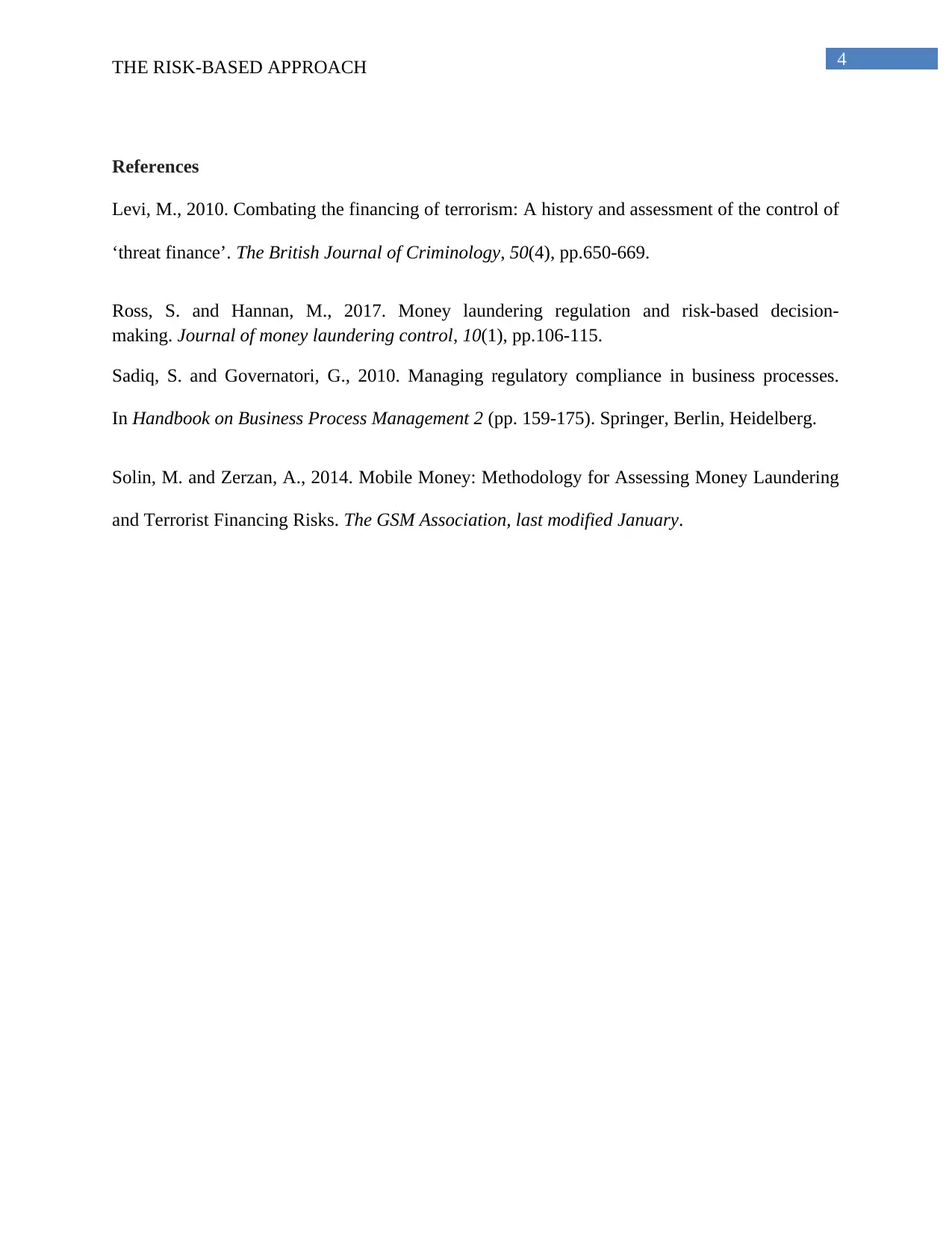
4THE RISK-BASED APPROACH
References
Levi, M., 2010. Combating the financing of terrorism: A history and assessment of the control of
‘threat finance’. The British Journal of Criminology, 50(4), pp.650-669.
Ross, S. and Hannan, M., 2017. Money laundering regulation and risk-based decision-
making. Journal of money laundering control, 10(1), pp.106-115.
Sadiq, S. and Governatori, G., 2010. Managing regulatory compliance in business processes.
In Handbook on Business Process Management 2 (pp. 159-175). Springer, Berlin, Heidelberg.
Solin, M. and Zerzan, A., 2014. Mobile Money: Methodology for Assessing Money Laundering
and Terrorist Financing Risks. The GSM Association, last modified January.
References
Levi, M., 2010. Combating the financing of terrorism: A history and assessment of the control of
‘threat finance’. The British Journal of Criminology, 50(4), pp.650-669.
Ross, S. and Hannan, M., 2017. Money laundering regulation and risk-based decision-
making. Journal of money laundering control, 10(1), pp.106-115.
Sadiq, S. and Governatori, G., 2010. Managing regulatory compliance in business processes.
In Handbook on Business Process Management 2 (pp. 159-175). Springer, Berlin, Heidelberg.
Solin, M. and Zerzan, A., 2014. Mobile Money: Methodology for Assessing Money Laundering
and Terrorist Financing Risks. The GSM Association, last modified January.
1 out of 5
Related Documents
Your All-in-One AI-Powered Toolkit for Academic Success.
+13062052269
info@desklib.com
Available 24*7 on WhatsApp / Email
![[object Object]](/_next/static/media/star-bottom.7253800d.svg)
Unlock your academic potential
Copyright © 2020–2025 A2Z Services. All Rights Reserved. Developed and managed by ZUCOL.





